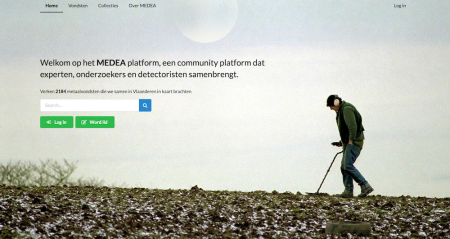Vondsten.be – the MEDEA platform
Metal detecting – searching for coins, pins and other metal objects with a metal detector – was prohibited by law for a long time, but the Flemish government has recently started to recognise detectorists and their obligation to report any finds.
In 2015, the Department of Arts and Archaeology at the Vrije Universiteit Brussel (VUB) developed the MEDEA platform in collaboration meemoo (formerly PACKED) to register metal detector finds and share knowledge about them. This platform has been managed by Histories with support from the Flanders Heritage Agency since 2019.
Challenge
Reporting metal detector finds is an important source for the government and archaeologists in identifying unknown sites with archaeological value. The previous ban on metal detecting overlooked the contribution that amateur detectorists can make to scientific research. This is why, in 2016, the Flemish government started to provide recognition and support for metal detectorists through knowledge-sharing and interaction between hobbyists and science experts in archaeology.
It did this as part of the MEDEA project, which then led to the vondsten.be platform, where amateur detectorists can register their finds and provide their own interpretations or estimates, which are then validated by academic experts. MEDEA was expanded in 2015 by the Department of Arts en Archaeology at the VUB, coordinated by Pieterjan Deckers and in collaboration with a number of partners. The platform also immediately serves as a reference database for researchers, detectorists and the broader public.
Our role
We developed a so-called graphical model for this platform – a data model where metadata is linked together by means of relationships, e.g. a find is (related to) a metal brooch, which was found in (or somewhere related to) Kortrijk, where other (related) discoveries were also found. A network of theorems such as this is comparable to the way our brains consider archaeological finds, and offers computers the possibility to ‘reason’ finds in a similar way. The means the database can easily record information that is often outside the scope of traditional assessment grids used in the heritage sector, so the data model can for example also show differences of opinion about how finds are classified.
We also developed use cases as a guide for developing the vondsten.be input interface. This development started at the end of 2015 and the platform went live online at the start of January 2017.
Approach
CIDOC-CRM
The graphical data model was developed in 2014 and 2015 on the basis of CIDOC-CRM (CRM stands for Conceptual Reference Model). This model doesn’t just contain information about the found object itself, but also about all events associated with the object, such as the search and the discovery, its classification and estimate provided by experts and researchers, and its inclusion in a collection. The MEDEA data model specification makes extensive use of existing implementations of CIDOC-CRM in other archaeological research projects to guarantee exchangeability with datasets in this domain. This is important because there are numerous international initiatives for collecting and sharing metal detection data.
Neo4j
The data model was implemented in a Neo4j-graph database at the end of 2015. The platform also includes an API which can be used to request data from the platform, and the data is released under an open content licence. The code from the platform was also released under an open licence, and the development was regularly updated by a number of panels of archaeologists and detectorists, who also tested the initial developments. These tests were supervised by the imec - SMIT research group at VUB (formerly iMinds-SMIT).
Human Centered Design Approach
The MEDEA interface was designed in various stages in 2015 and 2016, with additions always tested with future users, using a so-called Human Centred Design Approach. Standards, a flexible and versatile database system, developer-friendly APIs and open source software were used to achieve a system that can be expanded, reused and accessed online.
Read more about the platform development in the article ‘MEDEA, The Multidisciplinary Process of Setting Up A Crowd-Sourcing Platform for the Recording and Enriching of Archeaological Metal Detecting Data’.
You can find the platform code on GitHub.
Next stages
As a member of the steering group, we remain involved in the further development of the platform. For example, a project is starting this autumn to develop a new identification guide for identifying mediaeval metal. At the same time, the database is being supplemented with imports of metal finds from excavations by commercial archaeology companies. This new data is forming the reference framework for developing the new identification guide.
Partners
MEDEA is now a Histories project, funded by the Flanders Heritage Agency. It was originally a Brussels ErfgoedLab (BREL, departement History, Archaeology, Arts, Philosophy & Ethics, VUB), imec- SMIT, and meemoo, with support from the Vrije Universiteit Brussel and the Hercules Foundation. WeConnectData took care of the database development.

